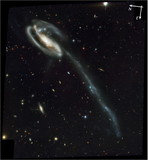Image Details

Caption: Fig. 11.
Color‐color plot in the VV 29 and NGC 4676 fields. Filled circles represent objects with star class ≥0.94 (i.e., likely to be stars), arrows correspond to objects not detected in the F475W filter (we show their 2 σ detection limits), and open circles represent galaxies, with the size proportional to their magnitude (the largest ones are ﹩I\approx 18﹩). The solid line corresponds to the ﹩z< 2﹩ color track of an elliptical galaxy, the dotted line to an Sbc with ﹩z< 3﹩ and the dashed line to a starburst. The thicknesses of the curves decrease with redshift. For clarity, we only plot 50% of the galaxies.
Copyright and Terms & Conditions
© 2004. The American Astronomical Society. All rights reserved. Printed in U.S.A.












